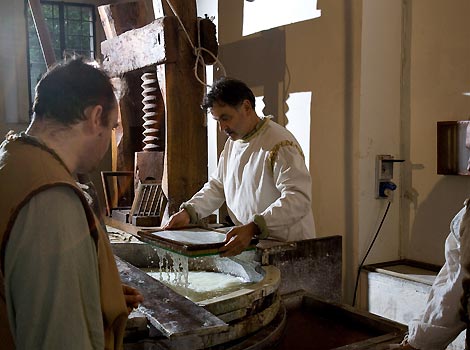Handmade paper
 Fabriano is one of the few cities in the entire world where, to this day, paper is still manufactured by hand; evidence of the determination to not give up on our centuries old tradition. The precious sheets that exit from the “tubs” department are utilized for prestigious editions, artistic designs and art prints, correspondence and invitation paper, University degrees, treasury bonds, etc. The raw materials used for this type of production are of the highest selection: cotton, hemp, linen, special colorants; and the very careful preparation of the paste carried out using the old Dutch refining tubs. The central workmanship phase has remained exactly as it was 700 years ago. The “worker” repeats the same movements, as did the Fabrianese paper makers of the 13th Century, immersing, with very delicate hand movements, the wire screen into the tub and extracting the same quantity of paste every time on the whole surface of the wire screen. The cast form is the means by which fibre is felted; the cast form consists of metal wire encased by a “deckle” (wooden frame used in making paper by hand) that is not fixed but rests on the perimeter of the wire screen to permit the bonding of the paste and limit the dimensions of the sheet of paper obtained. Then as soon as the sheet of paper is formed, the worker passes the form to the coucher, after which water is drained off for a moment, rests the form on a woollen felt causing the detachment of the sheet from the wire screen. One sheet and one felt, one on top of the other, forming a stack that is then placed under a hydraulic press: producing the first dehydration of the paper sheets. This particular operation reduces about 50% of water and allows the separation of the sheets from the felt, which can then be arranged on the “hangers”, and hung in large rooms where the air circulation and room temperature complete the drying process. The sizing operation follows the drying process: the dried paper sheets are immersed in an animal sizing tub that renders the paper ink proof and ensures preservation. At this point the paper is ready for the final desiccation again on hangers in the drying rooms. Finally the preparation operations where the paper sheets are “trimmed” via the “selection”, “counting”, “smashing”, “packing”, “glazing” and “curing” in the stock room. The production capacity of one “Tub” is greatly reduced and reaches a maximum of 100 kg daily.
Fabriano is one of the few cities in the entire world where, to this day, paper is still manufactured by hand; evidence of the determination to not give up on our centuries old tradition. The precious sheets that exit from the “tubs” department are utilized for prestigious editions, artistic designs and art prints, correspondence and invitation paper, University degrees, treasury bonds, etc. The raw materials used for this type of production are of the highest selection: cotton, hemp, linen, special colorants; and the very careful preparation of the paste carried out using the old Dutch refining tubs. The central workmanship phase has remained exactly as it was 700 years ago. The “worker” repeats the same movements, as did the Fabrianese paper makers of the 13th Century, immersing, with very delicate hand movements, the wire screen into the tub and extracting the same quantity of paste every time on the whole surface of the wire screen. The cast form is the means by which fibre is felted; the cast form consists of metal wire encased by a “deckle” (wooden frame used in making paper by hand) that is not fixed but rests on the perimeter of the wire screen to permit the bonding of the paste and limit the dimensions of the sheet of paper obtained. Then as soon as the sheet of paper is formed, the worker passes the form to the coucher, after which water is drained off for a moment, rests the form on a woollen felt causing the detachment of the sheet from the wire screen. One sheet and one felt, one on top of the other, forming a stack that is then placed under a hydraulic press: producing the first dehydration of the paper sheets. This particular operation reduces about 50% of water and allows the separation of the sheets from the felt, which can then be arranged on the “hangers”, and hung in large rooms where the air circulation and room temperature complete the drying process. The sizing operation follows the drying process: the dried paper sheets are immersed in an animal sizing tub that renders the paper ink proof and ensures preservation. At this point the paper is ready for the final desiccation again on hangers in the drying rooms. Finally the preparation operations where the paper sheets are “trimmed” via the “selection”, “counting”, “smashing”, “packing”, “glazing” and “curing” in the stock room. The production capacity of one “Tub” is greatly reduced and reaches a maximum of 100 kg daily.
